GECoPHONE Crystal Set No 1: BC1001 / BC1002
The GECoPHONE BC1001 / BC1002 was a British manufactured vintage radio crystal set dating from 1923 as it was the first model it was also known as Crystal Set No 1.
GECoPHONE Radios Includes:
GECoPHONE No 1 (BC1001 & BC1002)
GECoPHONE BC2830 TRF
Iconic radio receivers:
Summary of iconic radio receivers
Radio receiver history
Crystal radio sets
Development of the superhet radio
Radio history / timeline
The GECoPHONE No 1 crystal radio set was a vintage radio launched in 1923 in Britain to meet the growing demand for radio sets to receive the newly launched broadcast transmissions being transmitted around the country.
There were two versions of the GECoPHONE No 1 crystal set: the BC1001 and BC 1002. The difference was that the BC1001 had no cover on the crystal detector, whereas the BC1002 had a cover.
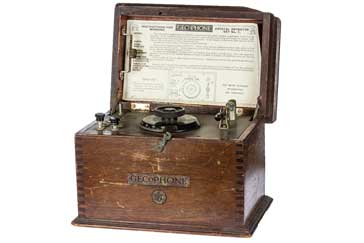
This actually shows the BC1001 version as there is no cover on the crystal detector
This vintage radio set was ideal for the time. It enabled many people to receive the new 'wireless' transmissions and although it was still relatively expensive, it was designed to keep the costs down as much as possible.
Today, a number of these antique radios are available in the collectors markets and the like, where they are sought after as one of the first commercially available roadcast radio receivers.
GECoPHONE manufacturer
The series of GECoPHONE radios as well as a number of telephones were made by the General Electric Co.Ltd. based in the UK.
The trade name GECoPHONE was used for a variety of products they made, but the name was only a brand name for some of their products and not the company name.
The name, GECoVALVE was also used by the company, and it would not be a surprise to learn that this was used for the valves they made.
The General Electric Company, GEC was founded in 1886 and made a very wide variety of electrical and electronic equipment during its life.
The company made everything from telecommunications equipment through to defence electronics and they also made a wide variety of electrical equipment as well.
In terms of the radios for domestic use, their production started at the company's Copsewood site in 1923. This included the GECoPHONE crystal sets, and later other valve based radios, again in the GECoPHONE series.
The brand name, GECoPHONE dropped out of use after a number of years and radios were marketed under the GEC name, although with stiffer competition, GEC focussed on other more profitable areas.
GECoPHONE No 1 crystal radio set specification
There was not much of a specification to accompany the GECoPHONE No 1 as formal specifications were not really needed at the time, and there was comparatively little about which a specification could be written about this vintage radio.
| GECoPHONE No 1 BC1001 / BC1002 Broad Specification |
|
|---|---|
| Parameter | Details |
| Summary | Crystal radio set for the long and medium wave bands |
| Date of introduction | 1923 |
| Cost at introduction | £5-10s-0d (£5.50 in todays UK currency system, although the value in 2022 is around £350) |
| Coverage | Medium wave band and long wave with additional coil |
| Detector | Described as "A specially sensitive crystal that does not require a potentiometer." |
| Output | High impedance headphones - provision for two sets of headphones to be used simultaneously |
| Aerial | Provision for aerials of medium or long lengths |
| Dimensions | 9 x 6¼ x 6 inch / 229 x 159 x 152 mm |
| Spare crystals | Bracket to hold three spare detector crystals located in the lid. |
| Approximate range (as given in the sales literature) | 25 miles |
The sales literature went on to say that the set was enclosed in a well-made polished mahogany case with nickel plated fastener and is supplied complete with two 10 foot lengths of flexible wire for connecting up to the aerial and earth, one coil of 100 foot 7/22 enamelled coper aerial wire, two insulators, one pulley block, one aerial fixing eye and one earth clip.
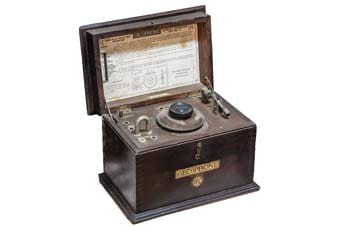
The sales leaflet also stated that full instructions were contained inside the case.
GECoPHONE BC1001 / BC1002 overall description
This vintage radio was contained within a polished mahogany box, which had a lift-up lid like so many of the sets of the day. This meant that when it was not in use it would not look "out-of-place" on the furniture of the day.
All the connections and controls were on an ebonite panel that was mounted so that it was covered byt he lid when it was closed.
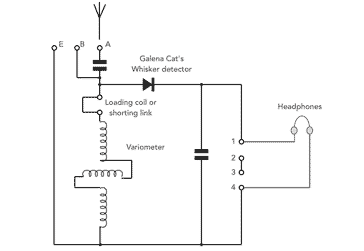
There were two connections for the aerial. Aerials longer than 60 feet were connected to connection "A" and medium length ones to "B".
There was a coupling capacitor that was placed in series with the "A" connection and this ensured that the capacitive loading on the tuner remained roughly the same for aerials connected to either A or B.
A good earth or ground connection was also required, and this was connected to the connection marked "EARTH" on the front panel of the receiver assembly.
Most of the wireless stations of the time were on what we now know as the medium wave band, and for this a shorting link was used across the "Loading Coil" terminals. This shorting link as removed and replaced with an external loading coil for longer wavelength reception.
Tuning was accomplished using a variometer form of inductance regime rather than a variable capacitor as these were not so easy to manufacture and they were not as widely available.
The Variometer was a rotary variable inductance attached to the dial on the top panel. The dial calibration was relatively arbitrary, but enabled people to return to the same dial position to quickly tune back to a popular station.
The signal detector was one of the famous Cat's Whisker detectors. This consisted of a piece of material, in this case galena onto which a small wire was placed. This formed what we now call a Schottky diode and it enabled the detection of the signals. Although it may ahve seemed crude by today's standards, many antique radios used this approach and it worked well.
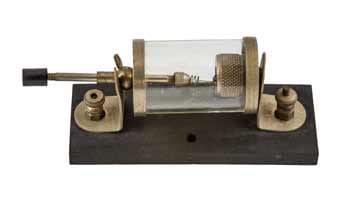
The detector would only remain active for a while and then a new position on the crystal was needed. After a while a new crystal was needed, but these were widely available at the time.
There was provision for one or two headphones on this vintage radio. These were connected to the sockets marked headphones. If only one set of headphones was to be used then they would be connected to terminals 1 and 4, but if two were to be used, then one set would be connected to 1 and 2 and the other to 3 and 4.
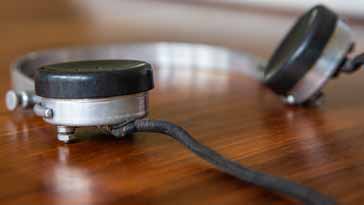
The radio came in two basic types: the BC1001 model had an open detector, but the BC1002 had a covered of closed detector with a covering over the detector assembly to give more protection.
Loading coils
In order to be able to cover the longer wavelengths, coils referred to as loading coils were used. These plugged into the connectors marked as loading coils on the front panel, having removing the shorting link.
The coils were multi-layered and enclosed in a flat ebonite cases, and they had 2-pin plugs for insertion in the sockets provided on the GECoPHONE receiving sets. The coils had adjustable aluminium vanes on the outside - these could have their position adjusted to trim the coverage for the coil in question.
There were several different coils manufactured that gave different coverage values - that actual values for the coverage also depended upon the type of radio set with which they were used.
The different coils could be selected to give the wavelengths that needed to be covered in a particular area.
BBC stamp on radio
All commercially manufactured British radios of the time had a "BBC" mark on them - many very early British vintage radios bear this mark.
The mark, a little like a "CE" mark today was introduced in the early days of broadcasting in Great Britain. To obtain the mark, the radio had to be British manufactured by a member company of the British Broadcasting Company (as the BBC then was) and approved by the Post Master General.
All wireless equipment that was manufactured for broadcast use had to bear the BBC/PMG stamp together with a G.P.O. registration number GPO being the General Post Office who controlled the use of wireless equipment.
Each wireless set that carried the BBC mark had to pay a significant royalty to the BBC / GPO and this was intended to ensure that the wireless systems were regulated.
In addition to this, the radio carried what could be called a type approval number. This was the registration number given to that particular type of wireless equipment when it was submitted for approval.
The Type Approval number of the GECoPHONE No 1 set was Reg. 102 and this number appears on all the radios that were made. Interestingly a serial number also appears and it shows that a very large number were manufactured.
The approval scheme with its BBC mark and type approval was introduced in 1922, but abolished in 1924 as a wireless receiving licence was issued to collect funds for what soon became the British Broadcasting Corporation.
The GECoPHONE crystal radio set No 1, BC1001 or BC1002 was a very popular radio of its time. It enabled many people to start listening to the new wireless programmes that were being broadcast and although its cost was high for many families, it was nevertheless one of the much cheaper commercially made radios of its time. But technology moved on, and more stations started up and the need to more sophisticated radios was soon apparent.
Today, this vintage radio is well sought after by collectors as it represents an iconic wireless set of its time.
 Written by Ian Poole .
Written by Ian Poole .
Experienced electronics engineer and author.
More History:
Radio history timeline
History of the radio
Ham radio history
Coherer
Crystal radio
Magnetic detector
Spark transmitter
Morse telegraph
Valve / tube history
PN junction diode invention
Transistor
Integrated circuit
Quartz crystals
Classic radios
Mobile telecoms history
Vintage mobile phones
Return to History menu . . .


